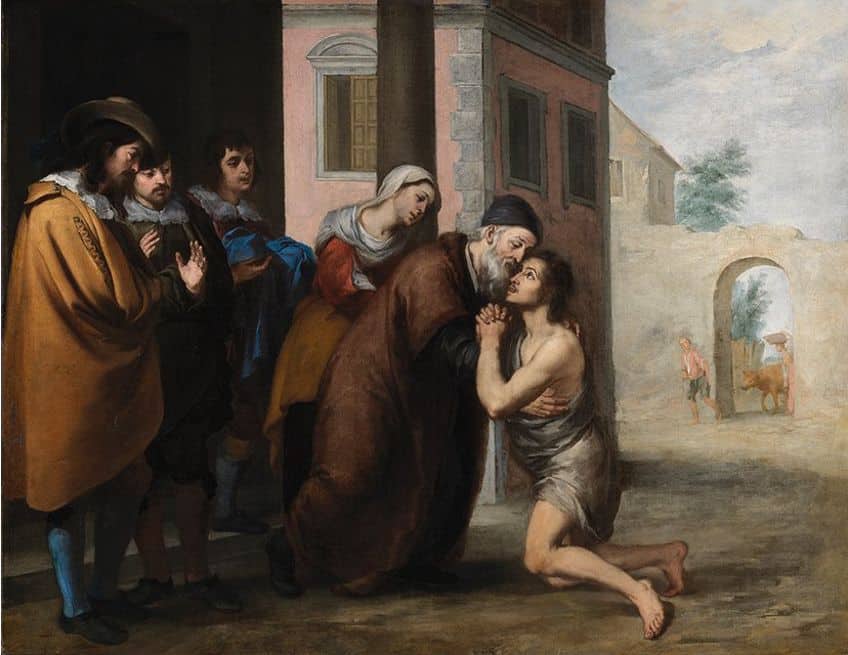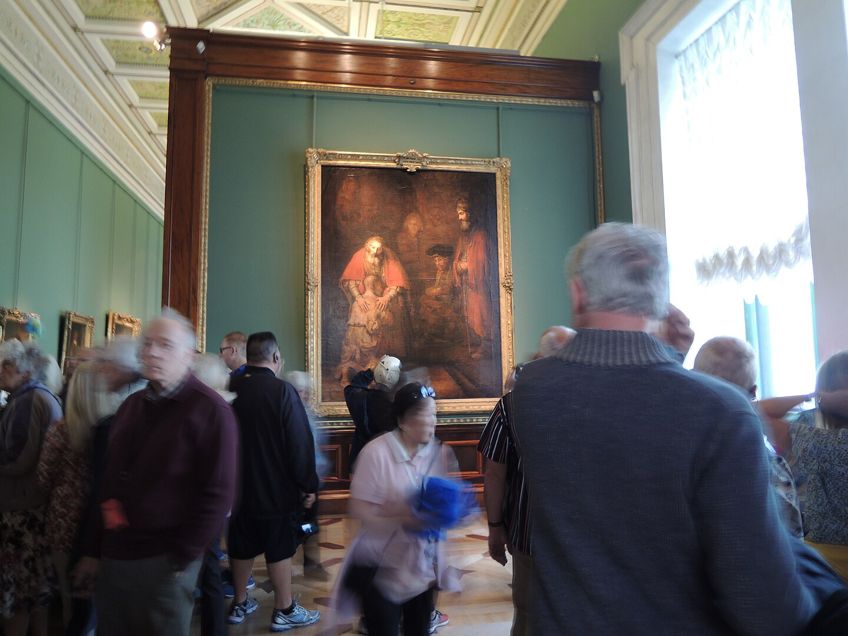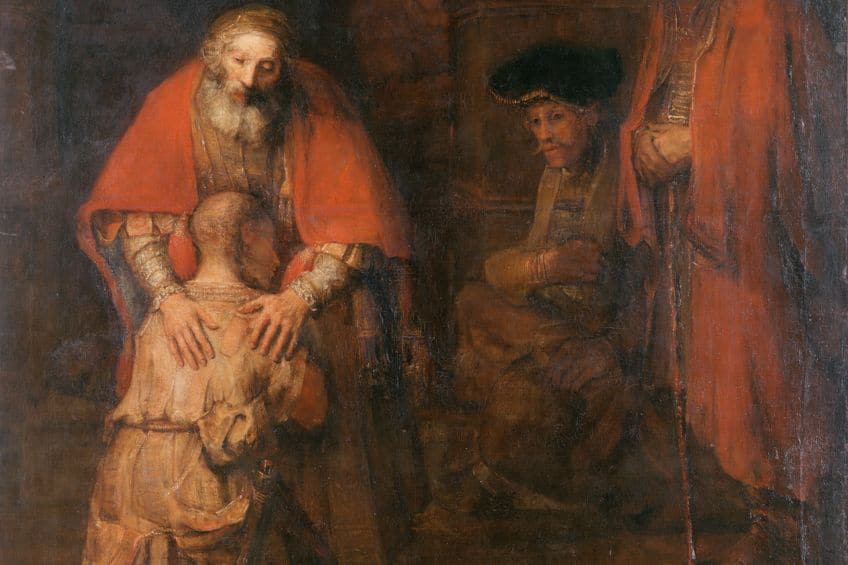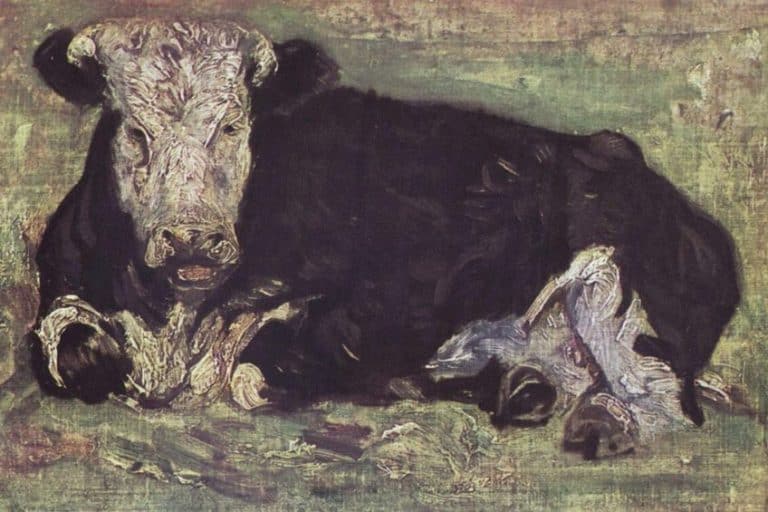“The Return of the Prodigal Son” by Rembrandt van Rijn – Analysis
The Return of the Prodigal Son by Rembrandt van Rijn is a masterpiece that captures the essence of forgiveness, redemption, and human emotion with unparalleled depth. Completed towards the end of Rembrandt’s life, this iconic work showcases his mastery of light and shadow, conveying a profound narrative drawn from the biblical parable. Through skillful brushwork and a keen understanding of the human psyche, Rembrandt brings to life a timeless story that continues to resonate with audiences, inviting us to reflect on themes of compassion, reconciliation, and the complexities of human relationships.
Key Takeaways
- Rembrandt’s painting is a revered example of his powerful storytelling through art, illustrating themes of forgiveness.
- The artwork is famous for its dramatic use of chiaroscuro and insightful portrayal of human emotions.
- It holds a prominent place in art history, both for its narrative depth and its visual mastery.
Art Historical Context
| Artist | Rembrandt van Rijn (1606 – 1669) |
| Date Created | 1661 – 1669 |
| Medium | Oil on canvas |
| Genre | Biblical painting and Baroque art |
| Period/Movement | Dutch Golden Age |
| Dimensions (cm) | 262 x 205 |
| Series/Versions | Single version, no known series |
| Where Is It Housed? | Hermitage Museum, Saint Petersburg, Russia |
| What It Is Worth | Priceless, as it is considered one of Rembrandt’s masterpieces |
The Return of the Prodigal Son is an iconic painting by Rembrandt van Rijn, a master of the Dutch Golden Age of painting. This work is celebrated for its emotional depth and the complexity of its themes. Rembrandt completed this painting towards the end of his career, which was marked by personal tragedy and financial difficulties. Yet, it stands as a powerful depiction of forgiveness and unconditional love, capturing a poignant moment from the biblical parable in which a wayward son returns to his father’s embrace after squandering his inheritance.

Located in the Hermitage Museum in St. Petersburg, Russia, the painting is noted for its dramatic use of light and shadow, a technique Rembrandt employed to guide viewers’ focus and to heighten the emotional intensity of the scene. The play of light accentuates the varied expressions of the characters, each reflecting a different reaction to the son’s homecoming, thereby enriching the narrative. This masterpiece remains a subject of extensive analysis and interpretation, cementing Rembrandt’s legacy as one of the greatest visual artists in history.
Rembrandt’s Artistic Influence
Regarded as a central figure in art history, Rembrandt van Rijn is often referenced as a Dutch Master due to his significant contributions to art during the Dutch Golden Age. He is best known for his intricate use of light and shadow, a technique known as chiaroscuro, which became a defining characteristic of the Baroque period. Baroque artists like Rembrandt sought to evoke emotion and emphasize dramatic contrasts, deeply influencing European painting.
Rembrandt’s works were grounded in human experience, characterized by their emotional depth and realism. His paintings often depicted biblical and historical scenes, as well as portrayals of contemporary Dutch life.
The Return of the Prodigal Son is a prime example of how Rembrandt applied his artistic philosophy, revealing an intimate moment in a manner that is both dynamic and tender. His influence extended beyond his own generation and continued to inspire artists for centuries, making him one of the enduring icons of Western art. Through his work, Rembrandt helped to shape the course of art history, and The Return of the Prodigal Son remains a powerful manifestation of his artistic legacy.
Analyzing the Masterpiece
The Return of the Prodigal Son is a captivating oil painting that skillfully captures the essence of compassion and forgiveness through its subject matter, use of color, and intricate symbolism.

Subject Matter
The central theme is the unconditional love and forgiveness of a father upon the return of his repentant younger son after squandering his inheritance.
The Return of the Prodigal Son faithfully illustrates a moving scene from the Biblical parable found in the Gospel of Luke.

Use of Color
Rembrandt employs a subdued palette to evoke a sense of calmness and introspection. The father’s warm and comforting red cloak envelops the ragged son, orchestrating a focal point.
Meanwhile, the surrounding figures are cloaked in muted hues, directing all attention to the emotional reunion.

Symbolism in the Painting
Each element within The Return of the Prodigal Son is replete with symbolism. The father’s encompassing embrace symbolizes acceptance, the tattered clothing of the son signifies his past moral decay.
The contrasting reactions of the bystanders reflect varied human responses to forgiveness.

Use of Light and Shadow
Rembrandt’s mastery of chiaroscuro—contrast of light and shadow—is prominently on display. A divine light illuminates the father and son, signifying the moment of redemption.
This technique highlights the figures’ expressions, enhancing the painting’s emotional depth.

Realism and Emotion
The artist’s rendition is noted for its lifelike portrayals and emotional gravity. The realistic depiction of the characters’ faces, especially the serene gaze of the father, imbues the work with palpable tenderness and empathy.
This allows one to almost feel the weight of the son’s remorse and the warmth of the father’s forgiveness.

Narrative and Characters
Rembrandt’s The Return of the Prodigal Son is a visual representation of the biblical parable found in Luke 15:11-32, illustrating the moment of forgiveness and reconciliation between a father and his returning younger son, with other figures symbolizing disapproval and advice. The parable recounts the story of a younger son who demands his inheritance from his father to live independently. Squandering his wealth, he later realizes his mistake and returns home, seeking forgiveness.
The father, representing divine mercy, welcomes him with open arms, signifying unconditional love and forgiveness.
Depiction of the Father and Sons
- Father: The father, a central figure in the painting, is depicted with overwhelming compassion, enveloping the younger son in a protective embrace. His portrayal reflects the boundless grace offered to those who repent.
- Younger son: Kneeling before his father, the younger son appears worn and penitent, symbolizing remorse and the desire for atonement.
- Older son: Standing apart with a look of judgment, the elder son represents those who are self-righteous, struggling to accept the same compassion extended to the repentant.

Roles of the Servants and Advisor
- Servants: Attentive servants in the background react to the scene, illustrating varied societal perspectives on forgiveness.
- Advisor: A figure thought to be an advisor, often overlooked, stands by, symbolizing wisdom and the balance between emotional and rational responses to the prodigal son’s return.
Cultural and Religious Significance
Rembrandt’s The Return of the Prodigal Son has had a profound impact on both religious themes and cultural narratives, examining the essence of forgiveness and the dynamics of familial relationships. Theologians and art historians have long studied Rembrandt’s work for its profound religious sentiment, which resonates with core Christian ideas. Kenneth Clark, an eminent art historian, considered the painting among the greatest works ever for its emotional depth and spiritual richness. The artwork encapsulates the essence of forgiveness and redemption as central tenets of mainstream Christianity.
It eloquently visualizes the Biblical parable from Luke 15:11-32, where a wayward son is welcomed back by his father, symbolizing the boundless mercy of God as viewed by the Catholic Church.
Art historian H. W. Janson praised the psychological complexity with which Rembrandt infused the figures. The painting facilitates a bridge between religious ethos and human emotional experience. Additionally, Henri Nouwen, a respected theologian, spent much of his latter career exploring the painting’s religious significance, indicating its continual impact on modern Christian thought and living.

The Painting in Modern Culture
In modern culture, The Return of the Prodigal Son maintains its relevance and continues to inspire a dialogue on family and religious values. While mainstream Christianity has often used the parable as a teaching tool, the painting itself has transcended religious boundaries, influencing even those outside of the Christian faith, such as Jews and others, by its universal themes of reconciliation and unconditional love. Furthermore, the work’s influence can be felt across different mediums, including literature, music, and theater, evidencing its engrained status in cultural expression.
The multilayered interpretations of Rembrandt’s work demonstrate its ability to converse across centuries, embodying the timeless questions of human fault and divine grace.
Reception of the Artwork
The Return of the Prodigal Son by Rembrandt van Rijn has historically been met with profound admiration and scholarly praise. Esteemed as one of Rembrandt’s masterpieces, critics and art historians frequently discuss its emotional depth and technical mastery. Artistic circles regard the painting as a pinnacle of Rembrandt’s expressive chiaroscuro technique, where the interplay of light and shadow facilitates a dramatic and intimate portrayal of the biblical scene.
The artwork’s reception has been shaped significantly by its ability to convey complex human emotions, with viewers often struck by the palpable sense of forgiveness and redemption depicted.
In academic discussions, scholars dissect the intricate balance Rembrandt achieves between narrative and aesthetics. They note his capability to capture both the prodigal son’s contrition and the father’s unconditional love with subtle gestures and nuanced expressions.
 Return of the Prodigal Son by Rembrandt (2019); shakko, CC BY-SA 4.0, via Wikimedia Commons
Return of the Prodigal Son by Rembrandt (2019); shakko, CC BY-SA 4.0, via Wikimedia Commons
The painting’s significance transcends its immediate religious context, as it resonates with universal themes of human fallibility and parental compassion. These qualities have ensured its continued relevance and acclaim within the canon of Western art. At the Hermitage Museum in St. Petersburg, Russia, where it resides, The Return of the Prodigal Son attracts thousands of visitors annually. It is not only a highlight of the museum’s collection but also a vital piece for studying the evolution of European art and its socio-cultural implications. The painting’s enduring influence is evident in its frequent discussion in educational programs and its inspirational role for contemporary artists and thinkers.
The Return of the Prodigal Son by Rembrandt van Rijn stands as a testament to the enduring power of art to evoke deep emotional and spiritual responses. Its timeless themes of forgiveness, redemption, and the complexities of human relationships transcend the boundaries of time and culture, resonating with audiences across generations. Rembrandt’s masterful use of light, shadow, and expression imbues the painting with a sense of profound humanity, inviting viewers to contemplate the universal aspects of forgiveness and the journey towards inner peace. As one of Rembrandt’s most celebrated works, The Return of the Prodigal Son continues to captivate and inspire, reminding us of the transformative potential of compassion and the enduring relevance of timeless artistry.
Frequently Asked Questions
Who Are the Figures Depicted in The Return of the Prodigal Son by Rembrandt?
The central figures in the painting are the biblical characters from the parable of the prodigal son. They include the repentant son kneeling before his forgiving father, along with other onlookers which typically represent the older brother and possibly servants or family members.
What Is the Symbolism Behind the Hands in Rembrandt’s The Return of the Prodigal Son?
Rembrandt’s painting is notable for the tender portrayal of the father’s hands on the returning son, symbolizing forgiveness and mercy. The contrasting characteristics of the father’s hands—one appearing strong and masculine, the other gentle and feminine—may suggest the dual nature of the parental love, encompassing both the mother’s and father’s love.
How Does The Return of the Prodigal Son Reflect Rembrandt’s Artistic Style?
The Return of the Prodigal Son encapsulates Rembrandt’s style with its dramatic use of light and shadow, known as chiaroscuro, to highlight the emotional intensity of the reunion. His layering of paint, known as impasto, adds a tangible depth to the textures, particularly evident in the father’s garment, enhancing the realism for which Rembrandt is renowned.
Isabella studied at the University of Cape Town in South Africa and graduated with a Bachelor of Arts majoring in English Literature & Language and Psychology. Throughout her undergraduate years, she took Art History as an additional subject and absolutely loved it. Building on from her art history knowledge that began in high school, art has always been a particular area of fascination for her. From learning about artworks previously unknown to her, or sharpening her existing understanding of specific works, the ability to continue learning within this interesting sphere excites her greatly.
Her focal points of interest in art history encompass profiling specific artists and art movements, as it is these areas where she is able to really dig deep into the rich narrative of the art world. Additionally, she particularly enjoys exploring the different artistic styles of the 20th century, as well as the important impact that female artists have had on the development of art history.
Learn more about Isabella Meyer and the Art in Context Team.
Cite this Article
Isabella, Meyer, ““The Return of the Prodigal Son” by Rembrandt van Rijn – Analysis.” Art in Context. April 10, 2024. URL: https://artincontext.org/the-return-of-the-prodigal-son-by-rembrandt-van-rijn/
Meyer, I. (2024, 10 April). “The Return of the Prodigal Son” by Rembrandt van Rijn – Analysis. Art in Context. https://artincontext.org/the-return-of-the-prodigal-son-by-rembrandt-van-rijn/
Meyer, Isabella. ““The Return of the Prodigal Son” by Rembrandt van Rijn – Analysis.” Art in Context, April 10, 2024. https://artincontext.org/the-return-of-the-prodigal-son-by-rembrandt-van-rijn/.











